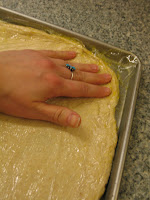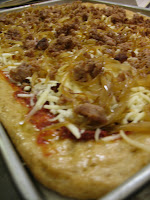Pizza Tonight!
My dad once went to a junkyard near home and bought a part for his still running, decrepit, '69 Datson 510 station-wagon, also known as the "Little Green Lima Bean". I don't remember what part he bought, but I do remember his description of the northern red-neck manning the junkyard. Scraggly hair, missing teeth, dirty pants and shirt. When daddy forked over the fifteen bucks for the part, the old codger crowed back towards his shack, "Pizza t'night!"
And that was that.
The car is long gone; the phrase stuck. I still think about it when I make pizza. And I love to make pizza. The dough is amazingly forgiving, and (with enough olive oil), it's crispy-tender loveliness. The toppings aren't half-bad, either.
This dough recipe comes from Rosemary Levey Barenbaum's Bread Bible-- a great cookbook for reading, learning, and baking. It's also one of the cookbooks in my growing-collection-that's-already-too-big that gives weights instead of just volume for flour. I've had a kitchen scale for a couple of years; I got it (for less than fifteen bucks) soon after I got my wheat grinder. I love it for several reasons:
- Flour's volume is affected by the weather and can vary up to (I think-- don't quote me) 1/4 cup, depending on how dry or damp the weather is. And 1/4-cup can be the difference between a dry cake and a moist one. The safest option is to weigh your flour when your concerned about moisture, or if you're just wanting to be careful.
- If you grind wheat, the volume between wheat berries and ground flour is quite different. If you're wanting to grind just enough, then your safest bet is to weigh your flour. (Though that's not really such a concern for me anymore; I just store the extra in the freezer.)
- It's also easier to just measure while you pour everything into the mixing bowl-- it actually takes a step out of the process of mixing and baking.
But this post is about pizza. I've made pizza dough before, but I never made pizza that tasted this good until I happened upon this recipe, in this cookbook. I think the key difference between this recipe and others is the wetness of the dough and the massive amount of olive oil. I also modify this recipe to include 1/2 whole wheat, though I'm sure you could do all. I would add about a teaspoon of gluten, and and I think you'd be set.
I also double this recipe from the original, since the amount of dough you get from the original recipe makes either a very small pizza or a very thin-crust pizza. I like thin crust, but my dad doesn't. And the little pizza doesn't make enough for even our small family.
One last note about the recipe: Ms. Barenbaum is nothing if not exact in her directions-- it's one reason her cookbooks are great for doing something for the first time. I tend to read through the directions the first 2-3 times, then follow my nose the rest of the way. You choose. :)
Perfect Pizza Dough
from the Bread Bible
8 oz. (1 1/2 c. plus 2 T.) flour (I use 1/2 whole wheat, 1/2 bread flour)
1 teaspoon yeast
1 teaspoon sugar
1 teaspoon salt
2/3 c. water
8 t. olive oil
1/2 - 1 t. wheat gluten (If using whole wheat and want a little more lift)
equipment:
1 large pizza pan, or a large brownie/edged sheet pan (my preference)
1 large pizza stone (I leave mine in the oven all the time-- it helps everything bake more evenly)
- One hour before shaping, (or for best flavor development, 8-24 hours ahead) mix the dough: Whisk together flour, yeast, sugar, and salt. Make a well in the center and pour in water. Using a rubber spatula or wooden spoon, gradually stir the flour into the water until all the flour is moistened and a dough just begins to form, about 20 seconds. It should come away from the bowl but still stick to it a little, and be a little rough looking, not smooth. Do not overmix-- it will make the dough stickier.
- Let the dough rise: Pour the oil into a 4-cup measuring cup (to give the dough room to double) or a bowl. With oiled fingers or an oiled spatula, place the dough in the measuring cup with the oil and turn it to coat on all sides. Cover it tightly with plastic wrap. If you want to use the dough immediately, allow to sit at room temperature for one hour or until doubled. For the best flavor development, make the dough at least 6 hours or up to 24 hours ahead, and allow it to sit at room temperature for only 30 minutes or until slightly puffy. Then set the dough, still in the measuring cup, in the refrigerator. Remove it on hour before you want to put it in the oven.
- Prepare the topping (ideas below)
- Preheat the oven: One hour before baking, move oven shelf to lowest position, place baking stone on shelf, and preheat to 475 Fahrenheit.
- Shape pizza and let it rise: With oiled fingers, lift the dough out of the measuring cup or bowl Holding the dough in one hand, pour a little of the oil left in the cup or bowl onto the pizza pan and spread it all over the bottom of the pan with your fingers. set the dough on the pans and press it down with your fingers do deflate it gently. Shape it into a smooth round (or rectangle) by tucking under the edges. IF there are any holes, kneatd it very lightly until smooth. Allow the dough to sit for 15 minutes, covered, to relax it.
Using your fingertips, pres the dough from the center to the outer edge to stretch it into the size of your pan. (I use oiled plastic wrap to help me stretch the pizza dough; if I do it with just my fingers, I always end up tearing the dough.) If the dough resists stretching, cover it with plastic wrap and let it rest for a few minutes longer before proceeding. After dough is stretched, brush it with any remaining olive oil. Cover with plastic wrap and let sit for 30-45 minutes, until it becomes light and slightly puffy with air. - Bake the pizza: Set the pizza pan directly on the hot stone and bake for 5 minutes.
- Add toppings
- Finish baking: Return the pan to the stone for another 5-10 minutes, until the cheese is melted and the crust is golden. For an extra-crisp crust, use a pancake turner or a baker's peel to slide the pizza directly onto the baking stone.
Toppings are something I don't get too persnickety about. There are thousands of ways to dress a pizza, and everyone's going to have their favorites. Here are some of mine:
Pizza Bianca with Sun-dried Tomatoes and Zucchini:
This pizza is great with a super-thin crust.
1/2-1 c. ricotta
3-4 T. Parmesan-Reggiano (freshly grated is the best)
1- 1 1/2 c. mozzarella
Sun-dried tomatoes
1 med. zucchini, sliced thinly
2-3 T. olive oil
Salt, pepper and spices (onion powder, garlic, parsley, a touch of nutmeg... whatever.)
(Or, my favorite store-bought seasoning blend for a lot of things--including zucchini-- is Simply Organic's Grilling Mates Chicken Seasoning.)
- Pour oil into a cast iron or frying pan and allow to heat. When hot, saute zucchini with salt, pepper and spices. Set aside.
- Spread ricotta on crust, sprinkle Parmesan-Reggiano and mozzarella on top. Finish with sun-dried tomatoes and sauteed zucchini. Finish in oven.
Caramelized Onion and Sausage Pizza:
1/2 lb. sausage
~2 T. olive oil
1 med-large onion, sliced in thin strips, end-to-end
~1 t. sugar
~1/4 c. white wine
salt to taste
Basic Pizza Sauce
OR: 1/2 c. Alfredo Sauce (homemade is super-wonderful)
1 T. Bleu Cheese or 1/4 c. feta cheese, crumbled
2 c. mozzarella cheese
- Fry sausage in a cast iron pan (or any frying pan-- I just like cast iron.) Remove from pan, leaving drippings.
- Add olive oil to pan and allow to heat. Add onions. Fry on medium-low heat. As onions start to color, add in white wine, sugar and salt (I usually eyeball these amounts). Let cook until onions are soft and caramelized, 20-30 minutes.
- Spread pizza or Alfredo sauce on pizza crust. If using Bleu cheese, sprinkle on top of pizza sauce. Add mozzarella on top, top with onions, then sausage. If using feta, sprinkle feta on top. Finish in oven.
Basic Pizza Sauce:
I never used to know what to do for pizza sauce until my friend Alyssa taught me a trick: just use tomato paste with some seasoning. So that's what I do now.
1 can tomato paste
salt and pepper to taste
2-3 tablespoons Italian Seasoning
- Mix all ingredients together. (Whew! Wasn't that hard?!) :P
2 T. butter
1/4 c. heavy whipping cream
1/2 c. freshly grated Parmesan cheese
salt and pepper to taste
(dash of nutmeg--optional)
- Melt butter into a sauce pan; add cream. Bring to a simmer, cook until cream starts to thicken. Remove from heat.
- Add in Parmesan and whisk until smooth. Season with salt, pepper, and nutmeg.













6 comments:
Um... yum?!
I cheat on pizza sauce and use organic spaghetti sauce out of the jar. It approximates pizza sauce pretty well. Pesto is also yummy if you have some in the freezer!
Sharon, I didn't even think about pesto. You're right, that would be great.
I used to use spaghetti sauce from the jar too; I really like tomato paste better. You should try it sometime!
Learned something about flour and moisture. Complicates cooking, but if it, but I can see where it would make a difference.
So does Humidity levels of winter vs summer greatly affect cooking that much?
Than if it does than western cooking (dry areas) must be different than eastern stateboard (humid areas).
Eaglegordon
Ah, now I know what to do with that tomato paste that's been sitting in pantry for the past two years, waiting on me to make homemade ketchup!
Tell me if you like it! And-- umm-- tell me how the homemade ketchup goes (if you ever make it... ) :D
Alex got me the Bread Bible for Christmas. I really haven't gotten too far in it yet. He also got me "The Art and Soul of Baking" by Cindy Mushet. I've been digging in it a good bit lately. As a matter of fact, the next recipe I was thinking about trying was the pizza dough recipe from there. I'll probably try it as breadsticks to see how well we like it before turning it into pizza.
Heather
Post a Comment